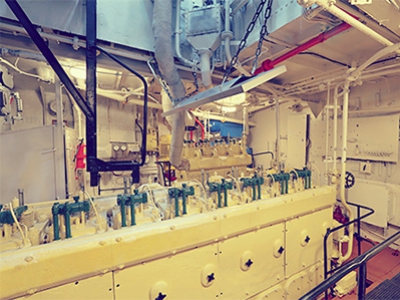IMCA Safety Flash summarizes key safety matters and incidents
IMCA has issued new Safety Flash summarizing key safety matters and highlighting lessons learned from maritime incidents.
One case refers to a near miss incident in whichan engine and shaft generator started running whilst a crew member was working on it. The incident occurred during planned monthly maintenance on carbon brushes on a propeller shaft located inside the pedestal underneath the generator. Whilst the crew member was performing his task, the duty engineer received an order from the bridge to start the port side main engine. The crew member was located inside the pedestal underneath the generator when the propeller shaft was clutched in and started rotating. He managed to escape from the area and reported the incident to engine control room (ECR) personnel.
There were no injuries, but this was a high potential incident with the possibility of a fatality or of life threatening injuries resulting in permanent disability.
Investigation Findings
- The isolation (lock out/tag out) system was not sufficient for this work on the generators. The port side main engine was in standby mode and there was no isolation to the system before starting the routine maintenance on the shaft;
- There was inadequate supervision. The crew member started the job unsupervised, and there was only limited confirmation from the crew member that he understood what the job entailed;
- There was incomplete understanding of how to approach a task of this sort safely, in terms of toolbox talks, permits to work and stop work authority;
- There was an unplanned change which was not properly managed. It had not been planned to turn the vessel when the electrician reviewed this planned or required maintenance work, and then when the decision was taken to turn the vessel, the electrician was not informed;
- There was a lack of communication during several phases of operation:
- engine control room (ECR) personnel and bridge personnel were not informed about maintenance on the generator
- the electrician was not informed of a planned turning of the vessel when preparing these tasks
- vessel personnel did not report the incident in timely manner the onshore organisation was not informed until 24 hours after the incident;
- There was insufficient knowledge of permit to work (PTW), isolations and barriers, and risk assessment requirements;
- There was a serious lack of compliance with existing company procedures:
- the pre-job conversation between supervisor and crew member was not in compliance with company requirements and procedures
- this was the third time the crew member had performed this task, and there was no PTW or isolation certificate completed on this occasion
- the opposite shift had also performed this task and had not used a PTW either, although there was a signboard in the ECR stating that work on equipment was in progress.
The following causes were identified:
Immediate causes:
- bridge and ECR not informed regarding on-going work on shaft generator
- port main engine in standby mode after unmanned engine room test;
Underlying causes:
- PTW and isolation certificate not issued
- risk assessment not followed
- failure to inform ECR on planned maintenance lack of robust communication routines;
Root causes:
- lack of safety awareness
- lack of management control.
| Lessonslearnt |
|
The following actions were taken immediately:
- Time out for safety held to discuss the incident, with focus on PTW, awareness and communication;
- Planned maintenance procedures updated with requirements for PTW and isolation of shaft generator;
- Sign made and posted on generator informing of lock tag requirements;
- Fleet-wide communication and discussion of incident.
The following further recommendations were made:
- Improvements should be made to toolbox talks and risk assessment for routine jobs, particularly with reference to isolations and barriers;
- Better pre-shift meetings in engine department should ensure good planning and identification of simultaneous activities;
- Stop work authority and behaviour based safety programmes should be reinforced.
Source:IMCA































































